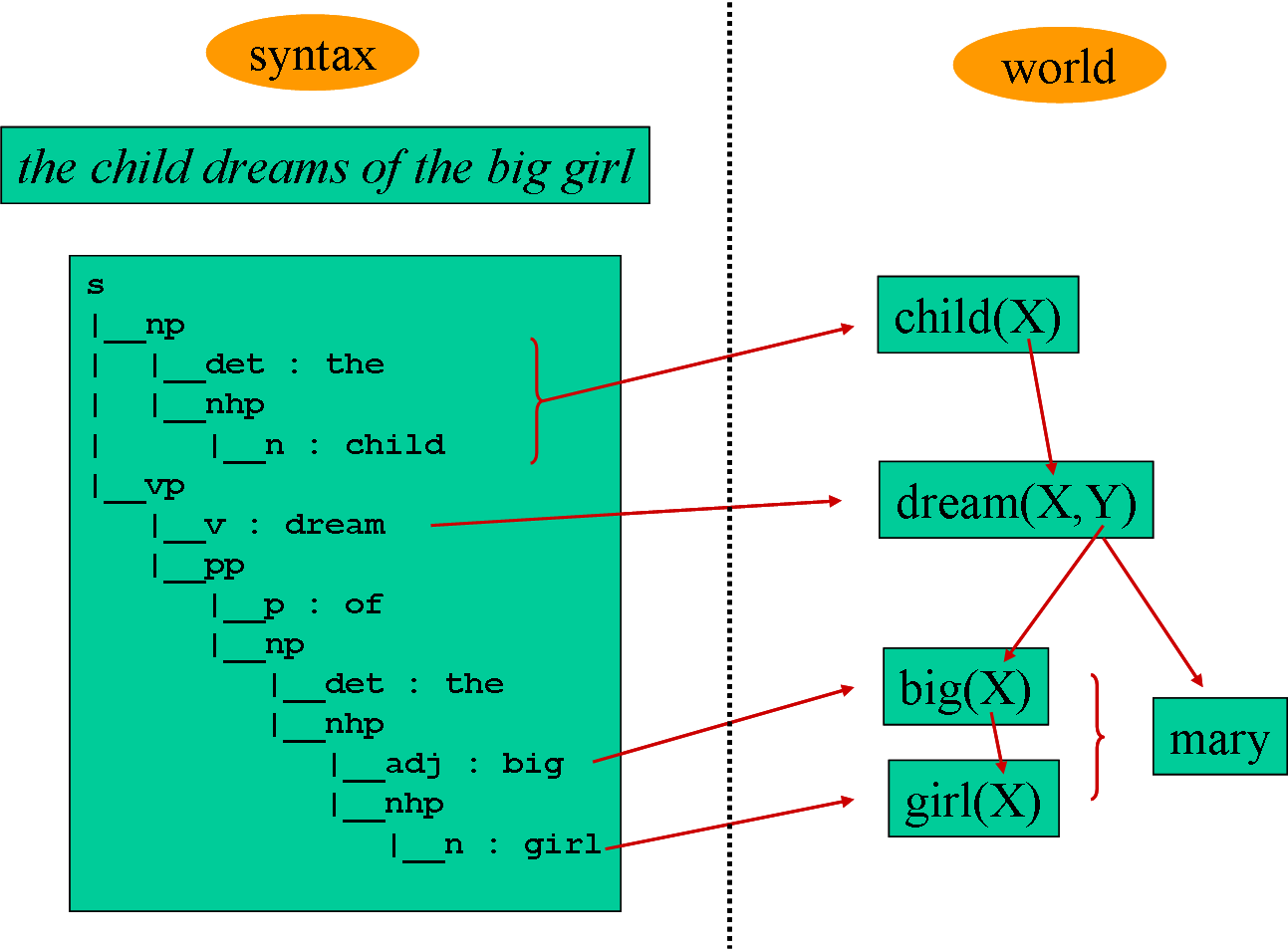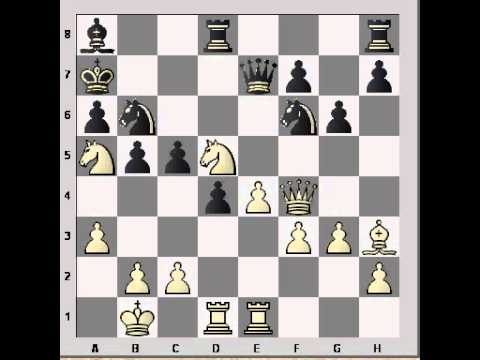
|
Telecom Paris
Dep. Informatique & Réseaux  J-L. Dessalles
← Home pageMay 2023
J-L. Dessalles
← Home pageMay 2023 |


Cognitive Approach to Natural Language Processing (SD213)
➜ other AI courses

Procedural semantics
The goal of the present lab work is to explore various ways to introduce semantic calculus on top of syntactic processing. In particular, we will illustrate the idea that semantic interpretation involves more than structural translation and requires some context-dependent calculus, according to what is called procedural semantics. For instance, we would like that a sentence like:
the child talks with the nice girl about the room
be interpreted, in an appropriate context, as:
talk(John, Ann, my_room)
Features structures
v([gloss:believe,num:sing,pers:3,subj:dp(_), cpl:[cp(that)]], believe(_,_), v(believe)) --> [believes].Note the three extra arguments in green, red and blue. These three extra arguments also appear in rules.
Here is the rule vp --> v, dp:
vp(FV,PVP,TVP) --> v(FV,PV,TV), dp(FDP,PDP,TDP),
{ % transitive verb, eg. 'like'
att(FV, cpl, [dp(FDP)]),
link(_, PV,PDP,PVP),
TVP = vp(TV,TDP) }.The above rule says that a verb phrase may consist of a verb followed by a determiner phrase: likes the boy.
The three extra arguments represent structures:
- FV: Feature structure (here for verb phrase) that is used to check various forms of agreement.
For instance, the feature structure attached to the verb believe is [gloss:believe,num:sing,pers:3,subj:dp(_), cpl:[cp(that)]].
(here, gloss indicates a string that is used in the output display) - PVP: Predicate (here, predicate for verb phrase) which will be used to compute the interpretation.
For instance: believe(_,_) - TVP: Tree structure for display (here for verb phrase).
For instance: v(believe)
- att is used to get the value of a feature (here cpl = complement) in the feature structure.
- link is used to perform the semantic link between syntactically connected phrases (see below).Note the presence of the determiner phrase dp, which linguists recommend to use instead of np (np is now used to represent undetermined noun phrases, like nice girl, whereas a nice girl becomes a dp). The files used during this lab work are in tp_sem.zip:
- sem_main.pl: main program - contains predicate link
- sem_Grammar.pl: grammar
- sem_world.pl: now empty - will contain domain knowledge
- sem_util.pl: utility predicates (no need to dive into this)
?- consult(sem_main).
true.
?- go.
sentence > the nice girl likes the boy
[gloss:like,num:sing,pers:3,subj:dp([gloss:girl,num:sing]),cpl:[dp([gloss:boy,num:sing])]]
s
|__dp
| |__det : the
| |__np
| |__adj : nice
| |__np
| |__n : girl
|__vp
|__v : like
|__dp
|__det : the
|__np
|__n : boy
- the child sleeps
- the child sleeps
- *the room sleeps
To do this, introduce a new attribute, anim, which may take two values: animate and inanimate. You may change the lexical entries of sleep, child and room, and the rule s --> dp, vp. to check for semantic agreement, so that the child sleeps be still accepted, while *the room sleeps become incorrect. Since other words in the lexicon may not have the attribute anim in their structure, the predicate att returns a variable when the attribute is absent. As a consequence, the game sleeps will still be accepted.
| Copy the new definitions of child and sleep here. |
| Copy the new rule s --> dp, vp.. |
What kind of attributes do you think could be used to discard nonsense sentences like:
|
Interfacing NL with Prolog
 Let’s say that in our context, The nice girl refers to Ann. To get this interpretation, some inference steps might be needed between words and meaning. Prolog seeems ideally suited to bridge the gap between natural language expression and meaning. The idea consists in representing the meaning of parsed sentences as Prolog programs that may be executed.
For instance, we expect the interpretation of the boy dreams of the nice girl to be boy(X), girl(Y), nice(Y), dream(X, Y) which, once executed, might end up as dream(john, ann) if the programme is able to understand that the nice girl stands for ann.As it stands, the program provides a minimal semantic interpretation:
Let’s say that in our context, The nice girl refers to Ann. To get this interpretation, some inference steps might be needed between words and meaning. Prolog seeems ideally suited to bridge the gap between natural language expression and meaning. The idea consists in representing the meaning of parsed sentences as Prolog programs that may be executed.
For instance, we expect the interpretation of the boy dreams of the nice girl to be boy(X), girl(Y), nice(Y), dream(X, Y) which, once executed, might end up as dream(john, ann) if the programme is able to understand that the nice girl stands for ann.As it stands, the program provides a minimal semantic interpretation:
?- go.
Sentence > the boy dreams of the nice girl
Syntactically correct
[gloss:dream,num:sing,pers:3,subj:dp([gloss:boy,num:sing]),cpl:[pp(of)]]
. . .
---> dream(_28336,_28338)
- perform semantic linking between merging phrases (e.g. dream(X,Y) and boy(Z) should share a variable when connected)
- execute recognized predicates (e.g. boy(Z) could return Z = john).
?- go.
Sentence > the boy dreams of the nice girl
dream(girl,boy)
this sentence makes sense
type [;] to see alternatives... ;
dream(boy,girl)
To do so, we might instantiate the first argument of link in sem_Grammar.pl whenever link is invoked. to indicate which argument of the first predicate should be shared. Replacing ‘_’ by 1 means that the first argument is shared; replacing it by 2 means that the second argument is shared, and so on.
If you do it correctly, the sentence the boy dreams of the nice girl will now receive only one interpretation.
| Copy the new rule s --> dp, vp. here. |
| Copy the new rule vp --> v, dp. here. |
|
Add a rule in sem_Grammar.pl for verbs that take two prepositional complements.
For instance, Ann talks with Pat about Mary should be successfully analyzed. Copy the rule below. |
Adding a procedural component to semantics
girl('Ann').
boy('John').
nice('Ann').Now we execute our interpreter again.
?- go.
Sentence > the boy dreams of the nice girl
[gloss:dream,num:sing,pers:3,subj:dp([gloss:boy,num:sing]),cpl:[pp(of)]]
--> dream(John,Ann)
this sentence makes sense
You may get the meaning of phrases instead of full sentences:
?- go(dp).
Phrase > the nice girl
Syntactically correct
[gloss:girl,num:sing]
girl(ann)
this sentence makes sense
|
Augment the world so that the child talks with the nice girl about the room may be interpreted as:
talk(John, Ann, my_room) talk(Pat, Ann, my_room)Insert the new clauses below. |
|
Introduce a new lexical entry daughter in the grammar and augment the world so that the child talks with the daughter of the nice girl about the room may be interpreted as:
talk(John, Lisa, my_room)Insert the lexical entry and the new clauses below. |
The current program does not "execute" to topmost phrase.
- Uncomment the "execute" line in dcg_parse to trigger the interpretion of the final output predicate.
- Add the following line to sem_world.pl:
dream(X, _) :- write('\n\t===> Continue to dream, '), write(X), writeln('!\n').
Limitation
The problem comes from the fact that Prolog’s execution of daughter('Ann', X) produces an instantiated predicate daughter('Ann', 'Lisa') instead of merely 'Lisa'.
To get around this problem, one could change the definition of ‘link’ to make it closer to a ‘merge’, that is, the output of daughter('Ann', X) should be ‘Lisa’ rather than an instantiated predicate.
Semantic contraints
- inflation of the number of features
- impossibility of nearly metaphorical expressions such as ‘a talking cat’, ‘talk with the parliament’, ‘we put our hope in Ann’.
|
Define animate by adding Prolog clauses to the world saying that
an entity is animate if it is a boy or if it is a girl.
Then add a predicate talk to the world that checks whether the two first arguments comply with the constraint of being animate.Insert the new clauses below. Does the program now make a difference between: - the girl talks with the child about Mary - the room talks with the child about Mary ? |
Interfacing NL with perception
 Since we established a connection between NL and Prolog, we can deal with spatial relations, up to a point.
Load the sem_Chess.pl program by adding the following line to sem_world.pl:
Since we established a connection between NL and Prolog, we can deal with spatial relations, up to a point.
Load the sem_Chess.pl program by adding the following line to sem_world.pl:
:- consult('sem_Chess.pl').This program contains the location of chess pieces on the chessboard pictured on the right. Normally, your program should be able to interpret the following phrases:
?- go(dp).
Phrase > the white knight
...> knight(white,(1,5))
|:
...> knight(white,(4,5))
?- go.
Sentence > the white knight is white
...> white(white)
|:
...> white(white)
?- go.
Sentence > the black knight is white
false.
n([gloss:right, num:sing],right(_,_),n(right)) --> [right].
?-go(pp).
Phrase > to the right of the white knight
...> right((2,5),(1,5))
|:
...> right((5,5),(4,5))
?-go(dp).
Phrase > the pawn to the right of the white knight
...> pawn(black,(2,5))
| Paste the modified clause of right. |
- Note: there are limits to the current implementation. For instance, you will get wrong results by checking the dp: "the pawn to the right of the black pawn". As you can see, the semantic link is sometimes established with the wrong argument of right(_,_). The problem comes from the fact that right(Loc) should be a function rather than a predicate. This problem could be fixed by reimplementing execute.
A word of conclusion
We must remain aware of a strong limitation, however. Syntax-semantics interfaces like the one illustrated in this lab work rely on the fact that words can be matched to predicates. For instance, the lexical entry 'believes' is matched to the predicate believe. This presupposes that part of the interpretation relies on a translation that uses a mental dictionary. The translation would merely associate words to predicates. This solution is better than nothing, but it is utterly simplistic from a cognitive point of view. A more realistic solution would consist in building predicates ‘on the fly’. This will be explained during the lectures.
Webography
 Back to main page
Back to main page





